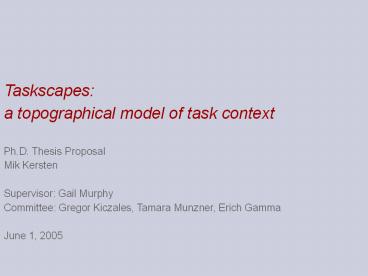Aspect-Oriented Programming with AspectJ - PowerPoint PPT Presentation
1 / 22
Title:
Aspect-Oriented Programming with AspectJ
Description:
Committee: Gregor Kiczales, Tamara Munzner, Erich Gamma. June 1, 2005 ... IDEs surface all of the complexity. Result is information overload ... – PowerPoint PPT presentation
Number of Views:63
Avg rating:3.0/5.0
Title: Aspect-Oriented Programming with AspectJ
1
Taskscapesa topographical model of task
contextPh.D. Thesis ProposalMik
KerstenSupervisor Gail MurphyCommittee
Gregor Kiczales, Tamara Munzner, Erich
GammaJune 1, 2005
2
Systems are complex IDEs surface all of the
complexity Result is information overload
3
Existing approaches
- Make systems less complex with better modularity
- Optimists think AOP or MDD could reduce size by
1/3 - Helps, but not enough
- Focus the relevant structure with multiple views
- Contents of each become overpopulated
- Filters are hard to manage and keep up-to-date
- Make the structure easier to access with queries
- Burden of formulating queries is on the
programmer - Each approach focuses on the system structure
4
What if we focus on task structure?
- While system complexity continues to grow, the
complexity of tasks programmers perform is
limited - Current tools make system structure explicit
- As a result end up showing too much
- Programmers waste time looking for the subset of
information relevant to the task at hand - Why not make the task context explicit, so
programmers see only what the are working on?
5
Thesis statement
- Automatically encoding and displaying task
context makes programmers more productive - This presentation discusses
- How to encode it, and operate on the resulting
model - How to display it in current IDE views and
visualizations - How to measure and study effects on productivity
6
(No Transcript)
7
(No Transcript)
8
Approach
- Making task context explicit
- Model should be easy to display and operate on
- Predictable and transparent to the programmer
- Represent elements, relations, paths, groupings
- Information interaction history
- Selection, edit, command and query events
- Model taskscape
- A map of information relevant to the task
- Relevance is defined by degree of interest
Furnas 1986 - Function not of structure but of interaction
history
9
Degree of interest
DOI(e) A(e.selections) B(e.edits)
C(e.decay)
public WSIFMessage getOutputs() return
outputs
public WSIFMessage getOutputs()
return verify(outputs)
10
Once task context is explicit
- Treat parts of your system as a unit
- Do operations on them
- Work with multiple tasks contexts
- Save and restore
- Union and intersect
- Predict interest of related elements
- API clients
- Overriding methods
- Advice
c
c
d
a
b
b
11
Taskscapes
- History
- Event stream
- Taskscape
- Height interest of elements
- Arrangement in plane interest of relations
- Projections
12
Implementation Mylar
- Prototype built on Eclipse platform
- Eclipse provides extensible abstractions for
selections, editing, search, and display - Interaction history encoding
- Monitors selections, editing, navigation, and
commands - Task context display
- Filtering, highlighting, sorting, folding,
update - Predicted interest
- Active search and degrees of separation
- Active structure views
13
\
14
Validation
- Thesis automatically encoding and displaying
task context makes programmers more productive - Can it be extracted and surfaced effectively?
- Does it make programmers more productive?
- Need productivity measure
- Higher ratio implies more time working on task
and less time looking for information needed for
task - Less browsing elements and scrolling
- Less search invocation and result selection
- Additional measures
- Quantitative usage data and qualitative feedback
edits
edit ratio
selections
15
User studies
- Preliminary study
- 6 senior IBM enterprise app developers used early
Mylar version - Used Mylar views more than standard Eclipse
views, liked it - Edit ratio improved 15 across, 40 within most
active programmer - Big study
- 104 developers signed up so far
- 10 day study periods for baseline, interest, and
predicted interest - Statistics collected via taskscapes
- Element handles are obfuscated for privacy
- Answer additional questions about
- Task management work practice
- Predicted interest and active search (measured
with hit ratio)
16
Related work
- Interaction history (implicit interest model)
- App event monitoring Hilbert 1998, Smalltalk
history navigator VisualWorks - Query tools (implicit interest model)
- FEAT Robillard 2005, JQuery Janzen 2003,
automated Ye 2002 - Task management (no mapping to structure)
- UMEA monitors desktop apps Kaptelinin 2003,
WorkingSpheres discuss task context Gonzales
2004 - Visualization (limited interest model)
- Focuscontext Furnas 1986, Card 2002, edit
read wear Hill 1992, wear-based filtering
DeLine 2005 - Taskscapes
- Tasks and interaction history are first class
- Interest of arbitrary structural elements and
relations - Topographical representation, interest
propagation and prediction
17
Contributions
- Primary
- Implicitly encoded, topographical model of task
context - Integration of model into IDE views that make
task context explicit - Secondary
- Focuscontext visualization of task context
- Mechanism for sharing task context
18
Timeline
19
(No Transcript)
20
(No Transcript)
21
Architecture
22
mumble































